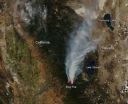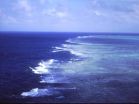(Press-News.org) Washington, DC— A team of researchers working on a Carnegie expedition in Australia's Great Barrier Reef has documented that coral growth rates have plummeted 40% since the mid-1970s. The scientists suggest that ocean acidification may be playing an important role in this perilous slowdown.
In a quest for historical context on the peril facing coral reefs, the team compared current measurements of the growth rate of a section of Australia's Great Barrier Reef with similar measurements taken more than 30 years ago. Their work is published in Geochimica et Cosmochimica Acta.
Coral reefs are havens for biodiversity and crucial for the economies of many coastal communities. But they are very sensitive to changes in ocean chemistry resulting from human activity. Since the beginning of the Industrial Revolution about one-third of the carbon dioxide, CO2, which has been released into the atmosphere from fossil fuel combustion and land use change has been absorbed by the oceans, where it damages coral reefs.
Coral reefs use a mineral called aragonite to make their skeletons, a process called calcification. It is a naturally occurring form of calcium carbonate, CaCO3. When carbon dioxide from the atmosphere is absorbed by the ocean, it forms carbonic acid, H2CO3, which makes the ocean more acidic and decreases its pH. This makes it more difficult for many marine organisms to grow their shells and skeletons, and threatens coral around the globe.
Recent studies have shown a reduction in individual coral growth in the Great Barrier Reef, southern Thailand, and the central Red Sea of between 13 percent and to 24 percent over the last few decades. But well-characterized observations of carbonate chemistry trends weren't made at those sites, so it isn't possible to draw a direct line of causality between the acidification of the ocean and a decline in coral skeleton building.
In order to establish a cause-and-effect relationship between acidification and decreased calcification, a team led by Carnegie's Ken Caldeira and including Carnegie's Jacob Silverman (the lead author) and Kenneth Schneider, formerly of Carnegie, compared measurements of the rate of calcification in one segment of Australia's Great Barrier Reef called Bird Island that were taken in between 1975 and 1979 to those made at the neighboring Lizard Island in 2008 and 2009.
The team found that rates of reef calcification were 40 percent lower in 2008 and 2009 than they were during the same season in 1975 and 1976.
However, the team was not able to demonstrate a change in the amount of live coral covering the reef structure over the three decade period.
If the reef in Australia is as sensitive to ocean acidification as was estimated by lead author Jack Silverman of Israel Oceanographic & Limnological Research Ltd in his previous work in Israel, then the increase in ocean acidification would be sufficient to explain the 40 percent decline.
Previous work by the group projected that all of the reefs in the world may be dissolving in a few decades if current carbon dioxide emission trends continue.
"Coral reefs are getting hammered," said Caldeira. "Ocean acidification, global warming, coastal pollution, and overfishing are all damaging coral reefs. Coral reefs have been around for millions of years, but are likely to become a thing of the past unless we start running our economy as if the sea and sky matters to us very soon."
INFORMATION:
This work was supported by the Moore foundation.
The Carnegie Institution for Science is a private, nonprofit organization headquartered in Washington, D.C., with six research departments throughout the U.S. Since its founding in 1902, the Carnegie Institution has been a pioneering force in basic scientific research. Carnegie scientists are leaders in plant biology, developmental biology, astronomy, materials science, global ecology, and Earth and planetary science.
Coral growth rate plummets in 30-year comparison
2014-09-17
ELSE PRESS RELEASES FROM THIS DATE:
Ebola outbreak 'out of all proportion' and severity cannot be predicted
2014-09-17
A mathematical model that replicates Ebola outbreaks can no longer be used to ascertain the eventual scale of the current epidemic, finds research conducted by the University of Warwick.
Dr Thomas House, of the University's Warwick Mathematics Institute, developed a model that incorporated data from past outbreaks that successfully replicated their eventual scale.
The research, titled Epidemiological Dynamics of Ebola Outbreaks and published by eLife, shows that when applying the available data from the ongoing 2014 outbreak to the model that it is, according to Dr ...
EARTH Magazine: The Bay Area's next 'big one' could strike as a series of quakes
2014-09-17
Alexandria, Va. — Most people are familiar with the Great 1906 San Francisco Earthquake and are aware of the earthquake risk posed to the Bay Area — and much of California — by the San Andreas Fault. Most people are not aware, however, that a cluster of large earthquakes struck the San Andreas and quite a few nearby faults in the 17th and 18th centuries. That cluster, according to new research, released about the same amount of energy throughout the Bay Area as the 1906 quake. Thus, it appears that the accumulated stress on the region's faults could be released in a series ...
Rooting out horse-meat fraud in the wake of a recent food scandal
2014-09-17
As the United Kingdom forms a new crime unit designed to fight food fraud — in response to an uproar last year over horse meat being passed off as beef — scientists from Germany are reporting a technique for detecting meat adulteration. They describe their approach, which represents a vast improvement over current methods, in ACS' Journal of Agricultural and Food Chemistry.
Hans-Ulrich Humpf and colleagues note that food fraud is a major global economic problem. But they also say that adding, for example, horse or pork to other meats without disclosure also can cause ...
California's King Fire east of Sacramento
2014-09-17
California's King Fire tripled in size from Monday, September 15 to Tuesday morning, September 16, and current weather conditions are doing nothing more than helping it along. The hot, drought conditions and winds have produced over 12 major fires that still burn all over California. The King Fire is just one of them. It is located east of Sacramento in the Pollock Pines community. Residents have been given mandatory evacuation orders and over 1,600 homes are currently threatened by this fire. It began Saturday September 13 and has spread rapidly through the area fueling ...
Elsevier journal Maturitas publishes position statement on breast cancer screening
2014-09-17
Amsterdam, September 17, 2014 – Elsevier, a world-leading provider of scientific, technical and medical information products and services, today announced the publication of a position statement by the European Menopause and Andropause Society (EMAS) in the journal Maturitas on the topic of breast cancer screening.
Breast cancer is the most prevalent cancer in women, with slightly more than ten percent developing the disease in Western countries. Mammography screening is a well-established method to detect breast cancer. However there are concerns about over diagnosis ...
Toward making lithium-sulfur batteries a commercial reality for a bigger energy punch
2014-09-17
A fevered search for the next great high-energy, rechargeable battery technology is on. Scientists are now reporting they have overcome key obstacles toward making lithium-sulfur (Li-S) batteries, which have the potential to leave today's lithium-ion technology in the dust. Their study appears in the ACS journal Nano Letters.
Xingcheng Xiao, Weidong Zhou, Mei Cai and their colleagues point out that the capabilities of lithium-ion batteries, which power many of our consumer electronics, as well as electric vehicles, have largely plateaued. Scientists have been pursuing ...
Environmentalists and industry duke it out over plastic bags
2014-09-17
Campaigns against disposable plastic shopping bags and their environmental impact recently scored a major win. In August, California lawmakers passed the first statewide ban on the bags, and Governor Jerry Brown is expected to sign it. But the plastic bag industry is not yielding without a fight, according to an article in Chemical & Engineering News, the weekly newsmagazine of the American Chemical Society.
Alexander Tullo, a senior correspondent with C&EN, reports that the anti-bag campaign logged its first small victory in 1990 when Nantucket became the first place ...
Mechanism behind age-dependent diabetes discovered
2014-09-17
Ageing of insulin-secreting cells is coupled to a progressive decline in signal transduction and insulin release, according to a recent study by researchers at Karolinska Institutet in Sweden. The finding, which is published in the journal Diabetes, provides a new molecular mechanism underlying age-related impairment of insulin-producing cells and diabetes.
Ageing is among the largest known risk factors for many diseases, and type 2 diabetes is no exception. People older than 65 years have an increased risk of developing type 2 diabetes if their insulin-producing cells ...
Study finds Great Barrier Reef is an effective wave absorber
2014-09-17
New research has found that the Great Barrier Reef, as a whole, is a remarkably effective wave absorber, despite large gaps between the reefs. This means that landward of the reefs, waves are mostly related to local winds rather than offshore wave conditions.
As waves break and reduce in height over reefs, this drives currents that are very important for the transport of nutrients and larvae. This reduction in wave height also has implications for shoreline stability.
The Great Barrier Reef in Australia is the largest coral reef system in the world, extending 2,300 ...
New MRI technique helps clinicians better predict outcomes following mild traumatic brain injury
2014-09-17
New Rochelle, NY, September 17, 2014—Diffusion Tensor Imaging (DTI), a specialized magnetic resonance imaging (MRI) technique that detects microstructural changes in brain tissue, can help physicians better predict the likelihood for poor clinical outcomes following mild traumatic brain injury compared to conventional imaging techniques such as computed tomography (CT), according to a new study published in Journal of Neurotrauma, a peer-reviewed journal from Mary Ann Liebert, Inc., publishers. The article is available free on the Journal of Neurotrauma website until October ...





